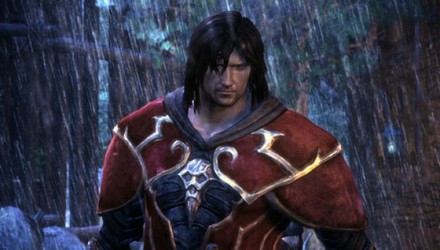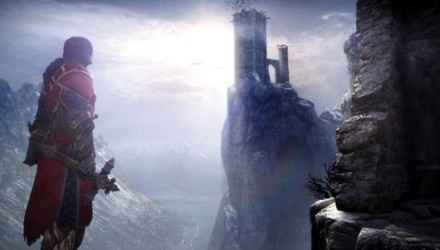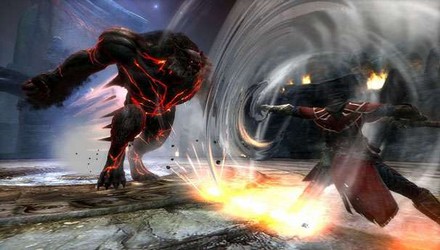Reviews
Review: Castlevania: Lords of Shadow
November 1, 2010, Author: Ray Willmott
When a new team is placed in charge of an established, beloved brand, measured with the task of making it up-to-date and current, bad things can happen. However, it is fair to say that the Castlevania series, at least when it pertains to home consoles, is in need of a new coat of paint. The series has found great success on handhelds and re-releases on arcade marketplaces of late, but as the recent ‘all-new’ Castlevania on XBLA proved, things needed to change.
Introducing Lords of Shadow, the first fully fledged 3D Castlevania game this gen. Scrapping the 2D side-scrolling look and feel of previous instalments for something entirely new is a big gamble, but with names like Hideo Kojima involved in the development and voice actors such as Patrick Stewart, Jason Issacs and Robert Carlyle pledging their support, surely this cannot fail? Can it?
On a dark, dark night…
Let me just start by saying this is a reboot, a re-imagining, a restart for a classic franchise. Die-hard Castlevania fans may even say that this is only Castlevania in name alone and while I wouldn’t stretch that far, I would be lying to you if I didn’t say that this was something completely different. You control Gabriel Belmont, a member of the Brotherhood of Light, a group that defends innocents against supernatural beings. Gabriel has been a member of the Brotherhood since his birth and has been raised in their ways throughout his infant years. However, it is not just the ways of the Brotherhood of Light that have kept his attention as a boy but the love of a childhood sweetheart, the girl who would become his wife, Marie. However, recent events haven’t been that kind to Gabriel and the story begins at a crossroads in his life, one that will utterly test his resolve.
After Marie is brutally murdered by the very entities Gabriel pursues, he becomes consumed by anger and despair, his thoughts alone turning toward her and revenge on those who have caused him such grief. Filled with questions, Gabriel turns to the Brotherhood, desperate for a strand of hope. They tell him that in their dreams they have seen ‘The Guardian of the Lake’ hidden deep in the forests; a being who can provide him with answers. With the faintest hope and unbridled fury smouldering within, Gabriel sets off on his journey. Of course, there’s much more to the story than this simple synopsis but I shan’t say anything more for the sake of spoilers. Suffice it to say, you don’t know the half of it!

It's a rainy day in hell!
This game didn’t just learn from the original Castlevania
LOS bears more similarities to the likes of Batman, God of War, Ninja Gaiden and Devil May Cry than any of its predecessors. LOS is about combos, gaining experience points to upgrade those combos, using a variety of moves to be most effective in combat and adapting your tactics for each battle. Gabriel starts the game equipped with an iron chain with a combat cross soldered on at the end. This will be familiar to anyone whose played Castlevania before and adds an air of authenticity to the game right from the get-go. However, Gabriel isn’t simply confined to a chain to quell his foes, there’s also a series of throwing daggers Gabriel can use from long range to attack his enemies and lure them toward him, alongside other collectibles he’ll obtain on his adventure. As you might expect, these weapons are upgraded as the game progresses, adding new spark to his attacks. Gabriel starts with the basic form of his iron chain/combat cross combination, but gradually evolves it to enable him to swing from high places or pull down weakened walls.
It’s a formula we’ve seen put to use effectively many times in the past; as we get deeper into the story the strength of the character grows. When you start the game, you’re only using half a game pad but by the end, you’re using every single button. While we’ve seen it before, it doesn’t undermine just how much of a clever way of phasing out the ‘tutorial’ section altogether it is. It’s also a great story mechanic that’s makes for effective character development.
It’s not just whips and knives however, as Gabriel will also make use of light and shadow magic to change the tide of battle. The energy from his fallen foes will be used to power Gabriel’s light and shadow magic. The light magic casts a blue haze around Gabriel and enables him to fight his enemies while at the same time regenerating his health and forcing his enemies to drop more energy once defeated. This is great for fighting lots of enemies at once. The shadow magic is different, giving Gabriel added damage to his attacks but at the cost of no energy being released from enemies and no health regeneration, thus it will drain that much quicker. These will need to be used tactically in battle in order to ensure he always maintains the advantage.
This game is mammoth in size and has a whopping 20–25 hours worth of gameplay just for a straight run-through. The game is split into chapters, and there are sections within those chapters that gradually develop the story. Each section has a percentage rating and in order to obtain 110% (yea, this game is cooler than the average) you’ll have to obtain all the collectibles in the level, complete it on all difficulties and complete a trial. Once you complete a level you unlock a trial for that level, which has one essential requirement you’ll need to complete. So, on the first level you’ll need to defeat the Warg but making sure a certain amount of villagers survive. Then on another level you’ll need to kill fifty goblins before completing the level. As you can see, some of these challenges are fairly straight forward but as you get further in the game, so they become increasingly difficult. In order to get full completion for the game however, you’ll need to do them all. This adds a lot of replayability to an already huge game as some of these challenges are especially difficult in comparison to others!

Landscapes afar
Creepy and kooky!
The cast of characters is weird and wonderful, and once again very faithful to the series, everything from Lycan to Spiders, Goblins and of course, Vampires. Each of these are bone-chillingly represented on the screen with magnificent vision perfectly accompanied by technical mastery. LOS is filled with beautiful artwork and spectacular landscapes which are, at times, simply breathtaking. Everything is spot on and picture perfect in this game; the environments are diverse and elegant enough in their own right that they suck you into the game the deeper you go, rather than disappoint you with monotony. Shadow is prevalent when it needs to be, atmosphere is always appropriate, and I feel the likeness that several people on the development team made toward the work of Guillermo Del Torro isn’t a far cry; I got some real Pans Labyrinth-esque feelings from this game which is totally fine with me.
The only issues I had during play were to do with the camera which was occasionally very awkward and seemed a bit adverse to the players progression, especially when climbing cliff faces or when moving about in a small, tight-nit room. This also brought along another bugbear with it when the game fails to reverse the controls appropriately when changing scenes. This is a problem that’s plagued third person games since the beginning of time, but it’s one, I would have thought, would have been phased out in 2010. Then again, this is probably why I don’t develop games. There are also quite a few sticking glitches in the game where Gabriel will get stuck in the ground or find himself jumping aimlessly to try to get away from a part of the background which has become an obstacle. Reluctantly, I’ve had to restart from the previous checkpoint a few times because I simply could not free my character. This was quite aggravating for me, especially when I had plough my way through a difficult battle, only then to get stuck and find I have to do it all over again.
However, these are minor discrepancies that only crop up now and again in the game, but do sometimes detract from the overall experience and quickly make you realise that this game isn’t as polished as it could or should be. Regardless, this is an absolutely stunning game that doesn’t just rely on it’s beauty to get by.
Hollywood and Choir ensemble
It’s not just the looks that make this game great as the voice acting is top-notch; in fact it’s so good you may even allow Patrick Stewart to narrate you through the story without darting straight into the game in-between levels. Mr Pickard rolls his tongue around the words of the story so effortlessly and eloquently that you’ll find it difficult not to be spellbound and inspired by his command of the English language.
As for Gabriel he is voiced by the always brilliant Robert Carlyle who manages to capture the myriad of emotion his character has been set to portray, perfectly. On the one hand, Gabriel is stricken with grief, addled by anxiety and filled with despair and hopelessness, and on the other he is ruthless and forthcoming, filled with a wisdom beyond his years and an iron will that seems impossible to break. With a gruff Scottish accent, Carlyle does a fantastic job with the lines given and really breathes life into his character.
Other voice actors of note include Jason Issacs (better known as Lucius Malfoy) and Natascha McElhone, as well as an ensemble cast of others. All actors are extremely fitting and suited to their roles.
It wouldn’t be Castlevania without a compelling soundtrack and this one is as enriching as any other instalment in the series. A Spanish composer, Óscar Araujo, was brought in to score the game and he’s done a truly magnificent job. The composer has remained traditional in some regard, using some classic Castlevania tunes in an orchestral form, but has also scored some unique pieces for the game. The score ranges beautifully and absolutely suits the level of action on the screen. Everything from the sounds of voices in the 80-strong choir, to the 120 piece orchestra, the music is a real mood setter. I find myself going to bed with the music continuing to buzz in my head, I find myself humming the melodies while waiting on the bus stop in the mornings and even singing along with the choir when I’ve achieved a particularly challenging puzzle. LOS has a very memorable soundtrack that is like honey to the ears and beautifully compliments the artwork, making for a total package that rarely fails to mesmerize and dazzle.

Whiptastic!
Just another Belmont?
This is leaps, bounds and miles better than any other 3D Castlevania game you’ve seen before. LOS essentially takes what you know about 3D Castlevania and spits in its face. It still offers the thrills and frights that fans of the series have come to love over the last twenty years but delivers it in a memorable, epic package that comes on two discs and will easily take you twenty-plus hours to complete from start to finish. While it’s faithful to how the series has been represented in the past, it finally pushes things forward and looks to the future with a glint of promise in its eyes.
If you want comparisons, it’s this years Arkham Asylum. If you want recommendations, you will not find much better out there than Lords of Shadow. Castlevania has finally broken its 3D curse and left me wanting more! Congratulations Mercury Steam, you’ve just given this old wavering whip-fest a new lease on life.



